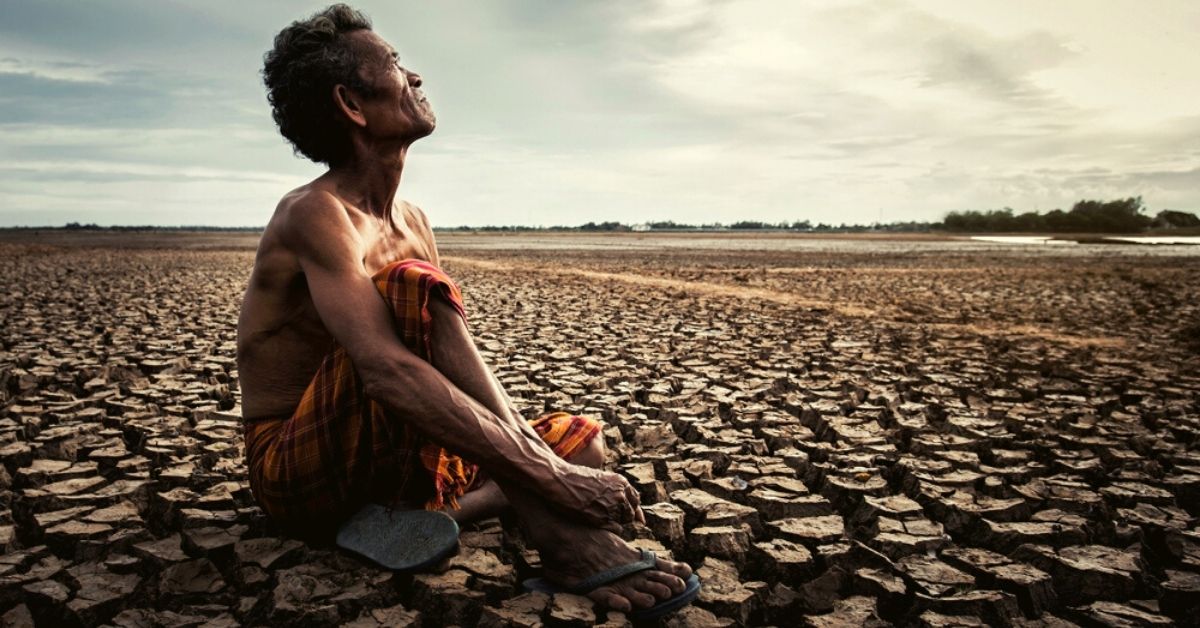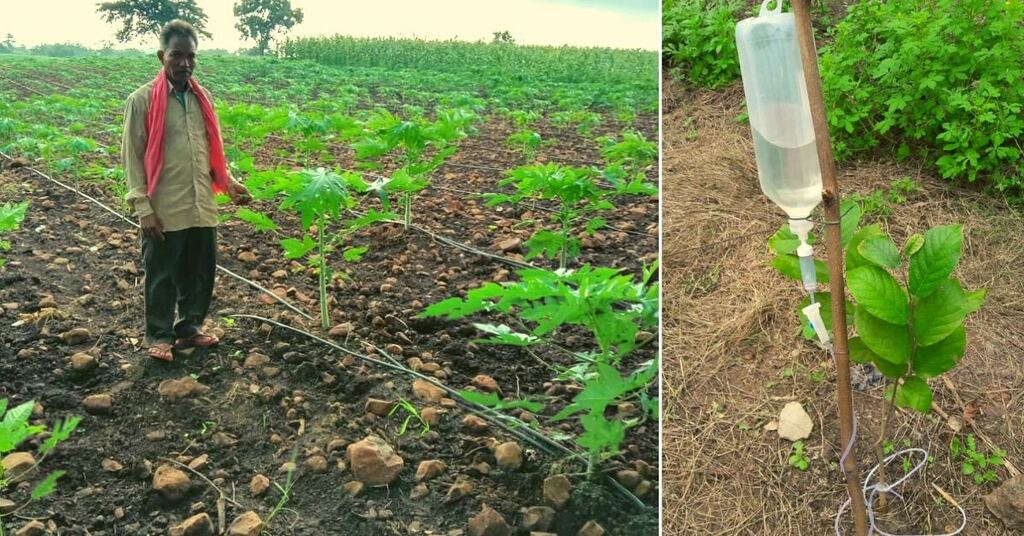MP Farmer Builds Irrigation System Using Waste Glucose Bottles; Now Earns in Lakhs
Ramesh Bariya was once neck-deep in debt and forced to work as a daily wage labourer. This method helped him turn his life around.

For many years, and several monsoons, the farmers of Jhabua district in Madhya Pradesh looked to the skies for showers. As they witnessed their crops die, lands go dry and families starve to near-death, many abandoned their villages to migrate for daily wage jobs in urban areas. Ramesh Bariya was one such farmer.
A native of Rotla village in the same district which is characterized by undulating topography, rainfed farming, shallow and eroded soils, low and stagnant soil productivity, fragmented and empty holdings and low income from ancestral farming, Ramesh was as frustrated as most of the farmers there.
All his attempts at farming were being undone by the unpredictable weather and water shortage, forcing him to wander across Gujarat and Rajasthan as a daily wage labourer.
“I had to feed my family somehow and the land was doing me no good. So I had to do whatever job I could manage to prevent my family from starving to death,” shares Ramesh, who had to return home after a few months due to the lack of livelihood opportunities.
While this is an unfortunate story that has become all too common, what’s different is Ramesh’s solution to all his woes — a unique DIY drip irrigation technique that not only solves the problem of water shortage but also recycles waste. From almost nothing to earning Rs 25,000 in a single yield in the first year, he soon became an example of change for the entire district.
And his journey began at Krishi Vigyan Kendra (KVK), Jhabua.
New Beginnings for a Farmer
Back in 2009, an initiative called the National Agricultural Innovation Sub Project (NAIP) under KVK was introduced to help enhance income of the farmers in the area. The objective of their integrated farming system was to sustainably improve rural livelihood in undulating and rainfed areas of Jhabua and Dhar districts of MP.

Ramesh was one of the beneficiary farmers who under the guidance of NAIP-KVK scientists began vegetable cultivation in a small area of 0.1 hectare. Encouraged by them, he prepared the land and in 2012, sowed seeds of bitter gourd and sponge gourd.
But after an initial profit, the delayed monsoons and an acute shortage of water pushed his farm to the brink of crop failure.
“Around the same time, we were made to visit Balaram Patidar’s farm. He is a well-known papaya farmer, and it was incredible to be surrounded by healthy trees. He even encouraged us to pluck some fruits and taste them. As the rest of the group of farmers proceeded to the next location with the KVK guide, I just stood there in awe. Then Balaramji approached me and asked me why I was so silent. I told him my dire situation and how shocked I was to see the absolute opposite in his farm. That’s when he showed me his drip irrigation technique using matka or earthen pots. Later the NAIP scientists also guided me to adopt this innovative technique using saline bottles,” says Ramesh.
However, at the time, Ramesh could not even afford to buy so many earthen pots for his farm. They were breakable as well as expensive to buy in large quantities and so he adopted the DIY technique of reusing plastic glucose bottles instead.
“In hospitals a single bottle of glucose can help revive a dying patient, then why can’t the same bottle be used to revive my dying crops? This idea made total sense and so I started to ask around and bought 6 kgs of plastic glucose bottles (total of 350) for Rs 20 per kg,” he says.
Dr IS Tomar, from Krishi Vigyan Kendra, Indian Council of Agriculture Research (ICAR) near Rajgarh Naka, Jhabua shared how this method by Ramesh was the first trial for a cheap and effective way of drip irrigation that could be replicated.
“For farmers like Ramesh who could not afford to buy drip irrigation systems, this was an innovative alternative. The only challenge was the hard work that went into it and lots of patience,” he says.
Installation and Maintenance

The technique involved cutting the bottom portion of the bottle with a sharp knife and hanging it upside down from a wooden stake next to the saplings. The bottom flat part now positioned on top is the inlet through which water is poured into the system. A plastic tube with a nozzle is then made to touch the ground near the root system of the plant for a regulated discharge of water.
Instead of directly having to pour the water on crops or channeling it through the field, this system allows the water to continuously drip making the surface moist at all times. Not only does this ensure that the roots have a continuous moisture but also reduces water wastage significantly.
“Almost the entire family helped out in the installation and maintenance of this system. In the morning all the kids in the house would line up near the field and begin pouring water into the bottles from 2 drums that I had already filled up using the well-water or the hand-pump. We would repeat this again in the evening. So daily, each of my crops would get two litres of water,” he explains. His total expenditure including the cost of drums was around Rs 500, and in a matter of months with the crops he managed to earn a net profit of Rs 25,000.

According to a report in Indian Council of Agricultural Research (ICAR), this method can help tribal farmers like Ramesh get about Rs 1.5 to 1.7 lakhs income per hectare in a single season of vegetable cultivation.
A popular technique in several African countries, Dr Tomar encourages more farmers to learn from this. With his guidance and Ramesh’s success story, many farmers in the region are now replicating this technique.
Ramesh’s efforts on the other hand, were recognised by the District Administration and Minister of Agriculture of the Madhya Pradesh government with an achievement award of Rs 10,000. In the next few years, KVK also helped him install a full-fledged drip irrigation system for free.
“I was once a man who was neck-deep in debt, hardly earning Rs 5 a day. But now, I earn around 2 lakh a year only through farming. Today, I am a happy man as a father of 3 naughty boys and a beautiful daughter, because I know that with this I can hope to give them a better future,” he concludes.
(Edited by Gayatri Mishra)
If you found our stories insightful, informative, or even just enjoyable, we invite you to consider making a voluntary payment to support the work we do at The Better India. Your contribution helps us continue producing quality content that educates, inspires, and drives positive change.
Choose one of the payment options below for your contribution-
By paying for the stories you value, you directly contribute to sustaining our efforts focused on making a difference in the world. Together, let’s ensure that impactful stories continue to be told and shared, enriching lives and communities alike.
Thank you for your support. Here are some frequently asked questions you might find helpful to know why you are contributing?


This story made me
-
97
-
121
-
89
-
167











